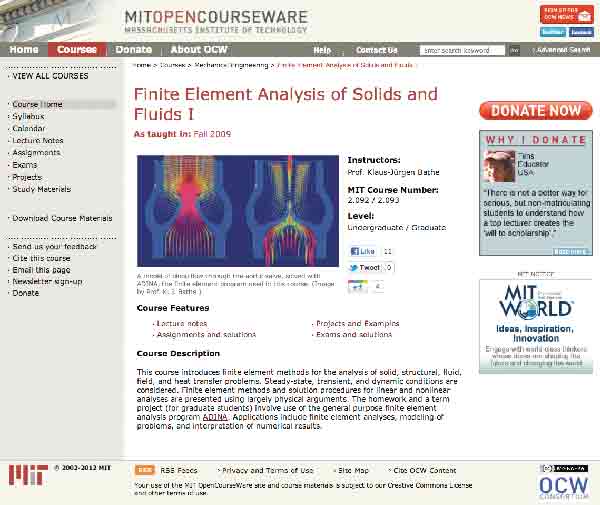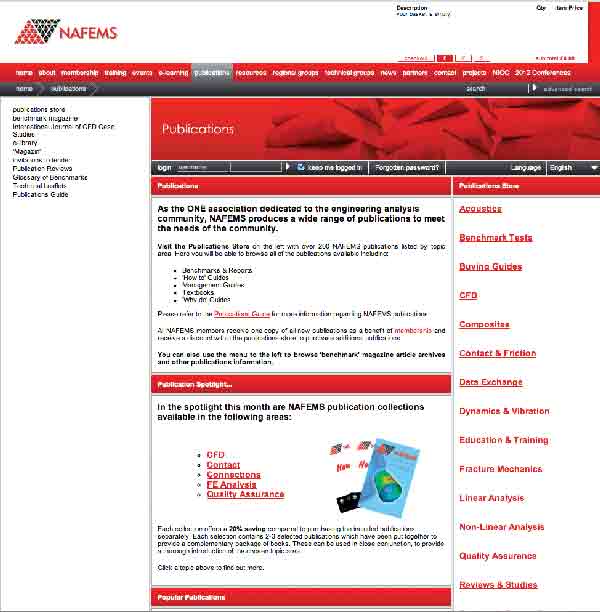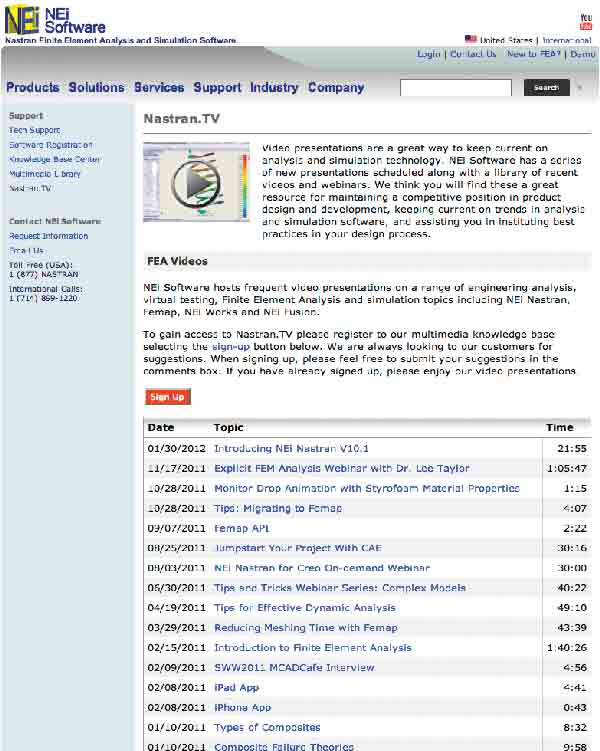Latest News
March 1, 2012
By Pamela J. Waterman
As a mechanical designer, you probably have a fairly solid background in finite element analysis (FEA). You learned the theory in college, and you may have some years of experience using a commercial software package. But unless you set up and perform daily finite element analyses, there’s probably room for improvement.
 MIT OpenCourseWare provides self-guided, online learning. |
Because no one argues with the theory of “garbage in, garbage out,” how can you zero in on the areas to refine, from preparing the CAD geometry to properly defining elements? And where will you find resources to do so?
DE asked seasoned FEA users, developers and educators for their best tips and pointers on learning actual FEA, as opposed to manipulating FEA software. With the variety of in-person, online, short-term, extended and even completely free resources available, you should find a learning opportunity that fits your needs, your time and your budget.
Advice from the Trenches
Some FEA missteps arise because GUI developers have actually done such a good job. Jeff Crompton, principal at AltaSim Technologies, an Ohio consulting company for simulated engineering solutions, knows this all too well.
“Commercial FEA programs have become increasingly easy to use,” he points out. “It is now relatively simple for anyone with limited experience and expertise to set up a problem, solve the problem and get a believable, but absolutely wrong answer.”
Crompton’s company is experienced in analyses for applications ranging from large-scale shipbuilding to small-scale implantable medical devices, specializing in COMSOL, Abaqus and LS-Dyna software. He has steered users onto the right path when their engineering problem exhibited some or all of the following issues: ill-conceived in the first place, set up with incorrect boundary conditions, inadequately meshed or not validated.
 NAFEMS offers e-learning programs via its website. |
“Material properties may not be as well-known as you suppose,” he offers as an example. “Just because the properties are tabulated in the FEA program doesn’t mean they are applicable to your problem.”
Pierre Theiffry, ANSYS lead product manager, structural mechanics, offers an additional consideration for problem set-up: “Even supplier data is (based on) nominal models. The CAD model differs from the actual part due to manufacturing differences. Everyone can get a result, but you need to know what is really important: What is really influencing your data?”
Users are advised to do a series of parametric analyses to investigate results for a range of values across the material properties, and across tolerance spreads.
Groups, Forums and Online Goldmines
To first identify what you need to know, the deciding factor—the “big one,” according to Mitch Muncy, Sr., engineering manager at NEi Software—is asking which analysis type you need.
“If I need to run linear statics or I need to run modal, do I know everything I need to know about modal analysis? The same goes with buckling or non-linear: How do I know what I need?” he says. “That will always be difficult, so what’s the quick and easy way to learn that?”
Many companies, including NEi Software, offer company-neutral materials, but first take a look at these outside sources.
New and Classic Books on FEA
|
If you’re not familiar with the UK-based professional organization NAFEMS, the International Association for the Engineering Analysis Community, you owe it to yourself to check them out. Vendor-neutral and dedicated to promoting every aspect of FEA (as well as computational fluid dynamics, or CFD), this group has been a pioneer in offering educational materials across many levels of end-user, from designer to analyst to manager. Its Benchmarks, Reports, “How To” and “Why Do” Guides are classics.
Although most NAFEMS in-person classes are presented in the UK, the organization’s e-learning programs are timed to work well for US-based participants. Eight code-independent e-courses address different levels of FEA use, from Practical Introduction to FEA and Basic FE Analysis sessions to Non-Linear and Dynamic FE Analysis, to name a few. Tony Abbey, NAFEMS’ principal trainer, has created and taught FEA training classes for more than 15 years; his e-classes generally run 2.5 hours/week for four weeks, allowing time to put the information into practice and line up more questions.
Other fee-based options include earning professional development hours (PDH) through PDHOnline, with courses such as “Introduction to Finite Element Methods” and “Basic Applied Finite Element Analysis” (prices vary), and taking the occasional FEA class from ASME (founded as the American Society of Mechanical Engineers).
 NEI and other vendors offer FEA training. |
On the free side, MIT OpenCourseWare is an increasingly popular approach to self-guided, online learning. Among many engineering subjects, it offers lecture notes, assignments, exams and study materials for the courses “Finite Element Analysis of Solids” and “Fluids I, II and III.” In addition, “Finite Element Procedures for Solids and Structures” is an MIT OCW classic video series presented by Dr. Klaus J rgen-Bathe, the founder/developer of ADINA nonlinear analysis software.
Two other options go deep into this topic. LearnersTV, a source of free online courses, offers the 30-lecture video series “Advanced Finite Element Analysis,” presented by Dr. R. Krishna Kumar, Department of Mechanical Engineering, IIT Madras. And the website of the University of Colorado at Boulder is home to a highly readable set of texts and slides for the course “Introduction to Finite Elements,” given by Dr. Carlos Felippa, Department of Aerospace Engineering Sciences.
Company Fare
Software vendors are also reaching out to users with an amazing variety of educational approaches, including traditional training (their location or yours), customized training, webinars, online courses and user groups. They generally cover a mix of software-specific and general-FEA topics. Many are free, so there’s almost no excuse for holding back. Here is a sampling with a media type for every taste:
- ANSYS offers dozens of webinars that its customers can download to learn at their own pace, such as “Ask the Expert—Structural Nonlinear Diagnostics in ANSYS 12.0,” and white papers such as “Incorporating Nonlinear Analysis into Routine Engineering Processes for Better Accuracy.” Customers can also phone in technical questions.
- MSC.Software lists 125 different free training videos, interactive tutorials and webinars, mostly with no registration necessary. Examples include “MSC Nastran Dynamics Solution Setup and Result Processing using Patran,” “Marc Adaptive Mesh Refinement” and “MD Nastran Essential Skill: Selecting What Dimension Finite Elements to Use.”
- NEi Software presents general and customized training classes; a distance learning program “FEA On-the-Go”; non-software-specific white papers and webinars in its online Knowledge Base Center (online under Support—sign-up is free); guides (“Composites Compendium” and “When Analysis Goes Nonlinear,” for example); and extensive Nastran.TV presentations ranging from five to 60 minutes (including “Tips for Complex Models” and “Explicit FEM Analysis”).
- SIMULIA gives dozens of introductory and advanced-application training classes for Abaqus software, plus access to the SIMULIA Learning Community (free, just register) with videos and how-to tips.
- SolidWorks produces seminars, blogs, tutorials and the lively SolidWorks Forums.
Consultant Power
Never underestimate the power of a consultant. Dedicated simulation companies have the experience and time to focus on FEA, and are in a great position to share knowledge through training classes.
George Laird, principal at Predictive Engineering, lives and breathes high-end mechanical analyses and knows the deep nuances of practical FEA—with more than 25 years’ experience on projects ranging from satellites and drilling platforms to engines and medical devices. Ask him for his opinions on self-training in FEA techniques, or take one of his in-depth courses, such as the two-day classes on “Foundations of (or Advanced) FEA Modeling with Femap and NX Nastran.”
It May be Time to Expand Your FEA Knowledge When You
|
Operating in the Real World
Good engineers know to explain their assumptions. J. Ben Deaton is a Ph.D. candidate in structural engineering at the Georgia Institute of Technology who writes about numerical models in his blog, “Only a Model,” at JBDeaton.com. He sets out a thoughtful checklist in the post called “How to Learn a New Finite Element Code,” then comments on the realities of presentations involving numerical (usually FEA) conclusions: “When all you say is, ‘We built a model and here is what we learned,’ you might as well say, ‘We got these numbers from our crystal ball!’”
Deaton suggests addressing the issue head-on, saying one could state, “We simulated the response using an ]algorithm name] approach in ]software name] with special attention given to ]key components of the model]. Our simulation neglected ]key things you forgot neglected] but was validated against ]other accepted numerical methods or experimental data] and shown suitable within ]whatever bounds].” Now you’re covered.
Acknowledging the potential for problems is definitely an important step. SolidWorks Simulation Product Manager Stephen Endersby sums up the learning process: “The thing to do when you are just starting out is to be a cynic. At first, assume some of the mistakes made are yours. Validate your assumptions before and after you run the simulation.”
Don’t forget the Keep It Simple, Stupid (KISS) rule, he adds: “Initially simplify the problem as much as possible, so you could almost get a textbook solution to the problem.”
Contributing Editor Pamela J. Waterman, DE’s simulation expert, is an electrical engineer and freelance technical writer based in Arizona. You can send her e-mail to [email protected].
MORE INFO
Subscribe to our FREE magazine, FREE email newsletters or both!
Latest News
About the Author
Pamela Waterman worked as Digital Engineering’s contributing editor for two decades. Contact her via .(JavaScript must be enabled to view this email address).
Follow DE





